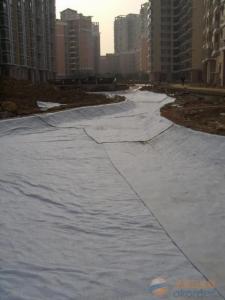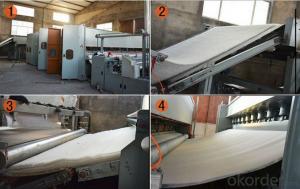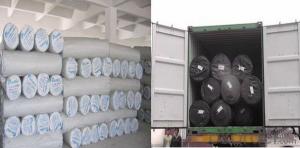Black Polypropylene Woven Geotextile for Construction
- Loading Port:
- Qingdao
- Payment Terms:
- TT or LC
- Min Order Qty:
- 20000 m²
- Supply Capability:
- 1500000 m²/month
OKorder Service Pledge
OKorder Financial Service
You Might Also Like
Black Polypropylene Woven Geotextile for Construction:
--Soild Durable
--Quality Guarantee
--Delivery Timely
Features of Black Polypropylene Woven Geotextile for Construction:
--Material: PP(polypropylene)
--Weight: 100-800g/sqm
--Weidth: 1-6m
--Length: 50-100m/Roll
Technical Data Sheet of Black Polypropylene Woven Geotextile for Construction:
NO. | Item Value | Specification | Note | ||||||||||
100 g | 150g | 200g | 250 g | 300 g | 350 g | 400 g | 450 g | 500 g | 600 g | 800 g | |||
1 | Weight Variation% | -8 | -8 | -8 | -8 | -7 | -7 | -7 | -7 | -6 | -6 | -6 | |
2 | Thickness mm≥ | 0.9 | 1.3 | 1.7 | 2.1 | 2.4 | 2.7 | 3.0 | 3.3 | 3.6 | 4.1 | 5.0 | |
3 | Width Variation % | -0.5 | |||||||||||
4 | Breaking Strength KN/m ≥ | 2.5 | 4.5 | 6.5 | 8.0 | 9.5 | 11.0 | 12.5 | 14.0 | 16.0 | 19.0 | 25.0 | MD and TD |
5 | Elongation at Break % | 25~100 | |||||||||||
6 | CBR Mullen Burst Strength KN≥ | 0.3 | 0.6 | 0.9 | 1.2 | 1.5 | 1.8 | 2.1 | 2.4 | 2.7 | 3.2 | 4.0 | |
7 | Sieve Size O90 mm | 0.07~0.2 | |||||||||||
8 | Vertical Permeability | K× (10-1~10-3) | k=1.0-9.9 | ||||||||||
9 | Tear Strength KN≥ | 0.08 | 0.12 | 0.16 | 0.20 | 0.24 | 0.28 | 0.33 | 0.38 | 0.42 | 0.46 | 0.6 | MD |
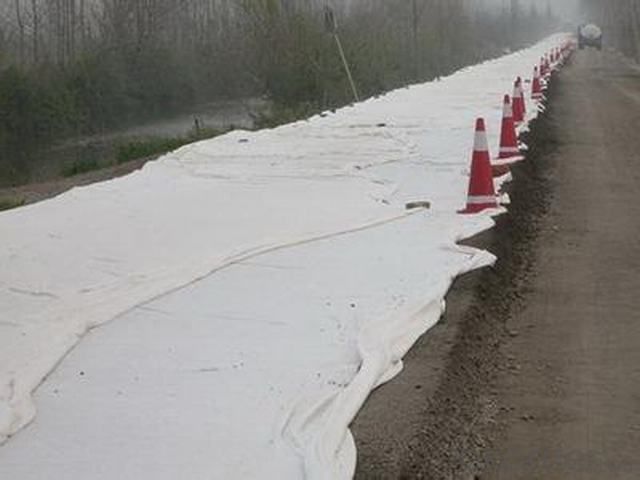
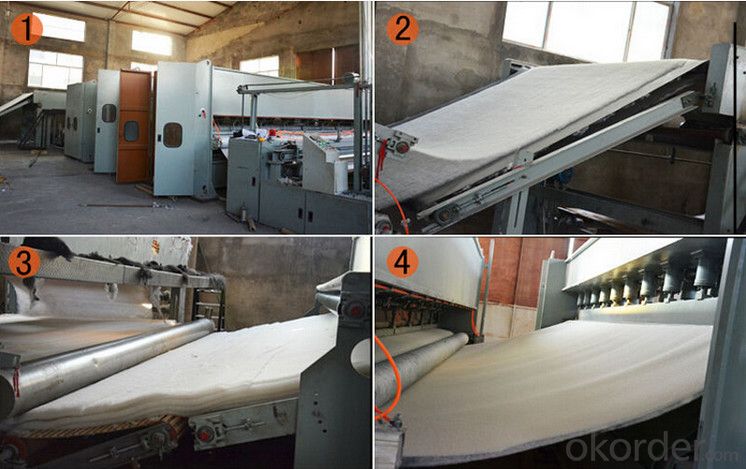
- Q:What are the factors affecting the selection of geotextiles?
- The factors affecting the selection of geotextiles include the specific application or project requirements, such as the desired strength, durability, and permeability of the geotextile. Other factors include the site conditions, including soil type, slope stability, and water conditions. Additionally, the cost, availability, and environmental considerations of the geotextile should also be taken into account during the selection process.
- Q:How do geotextiles help in the reduction of subgrade pumping?
- Geotextiles help in the reduction of subgrade pumping by acting as a filter and allowing water to pass through while preventing soil particles from being washed out. This helps to maintain the stability and strength of the subgrade, preventing the pumping of fine particles and water to the surface.
- Q:How do geotextiles help with soil reinforcement in soft ground conditions?
- Geotextiles help with soil reinforcement in soft ground conditions by providing a stable and strong layer that distributes the load more evenly. They act as a barrier and prevent the intermixing of different soil layers, improving the overall stability and strength of the ground. Additionally, geotextiles can help with drainage by allowing water to pass through while retaining the soil particles, preventing erosion and maintaining the integrity of the ground.
- Q:How do geotextiles reduce construction time and cost?
- Geotextiles reduce construction time and cost by providing several benefits. Firstly, they act as a separation layer, preventing the mixing of different types of soil, which eliminates the need for additional excavation and replacement. Secondly, they enhance the stability and strength of the soil, allowing for the use of less expensive and readily available materials in construction. Moreover, geotextiles minimize erosion and sedimentation, reducing the need for costly erosion control measures. Additionally, they can expedite the construction process by providing immediate load-bearing capacity, eliminating the need for time-consuming soil consolidation. Overall, geotextiles offer cost-effective solutions that save time, materials, and resources during construction.
- Q:How do geotextiles help with sediment control in construction sites?
- Geotextiles help with sediment control in construction sites by acting as a barrier that prevents soil erosion and sediment runoff. They are placed on the ground or slopes to stabilize the soil, allowing water to permeate through while trapping sediment particles. This helps to prevent sediment from being carried away by stormwater runoff, thereby reducing the risk of water pollution and ensuring compliance with environmental regulations.
- Q:What are the different manufacturing methods for geotextiles?
- There are several different manufacturing methods for geotextiles, including weaving, knitting, and nonwoven processes. Weaving involves interlacing two sets of yarns, warp, and weft, to create a fabric with an ordered structure. Knitting, on the other hand, uses a series of interconnected loops to form a fabric. Nonwoven processes involve bonding fibers together through methods such as needle punching, thermal bonding, or chemical bonding. Each method has its own advantages and is used depending on the specific requirements of the geotextile application.
- Q:How do geotextiles help with soil separation?
- Geotextiles help with soil separation by creating a barrier between different soil layers, preventing mixing and maintaining their distinct characteristics.
- Q:In the river within the construction of flexible piping can use geotextile to do anti-floating measures
- Yes, I am specialized in producing the installation
- Q:What are the different methods of geotextile installation?
- There are several different methods of geotextile installation, including trenching, direct placement, sewing, stapling, and adhesive bonding. Trenching involves excavating a trench and placing the geotextile fabric in it before backfilling. Direct placement involves simply unrolling and placing the geotextile on the desired surface. Sewing involves stitching the geotextile to another fabric or material, providing additional strength. Stapling involves using staples or nails to secure the geotextile to the ground or other surfaces. Adhesive bonding involves using specialized adhesives to attach the geotextile to the desired substrate. The choice of installation method depends on the specific project requirements and the type of geotextile being used.
- Q:Geotextile is what material to do
- In accordance with the manufacturing method is divided into: there are two types of textile and non-woven geotextile, varieties of filament and short wire, the main raw material is more polyester filament.
1. Manufacturer Overview |
|
|---|---|
| Location | |
| Year Established | |
| Annual Output Value | |
| Main Markets | |
| Company Certifications | |
2. Manufacturer Certificates |
|
|---|---|
| a) Certification Name | |
| Range | |
| Reference | |
| Validity Period | |
3. Manufacturer Capability |
|
|---|---|
| a)Trade Capacity | |
| Nearest Port | |
| Export Percentage | |
| No.of Employees in Trade Department | |
| Language Spoken: | |
| b)Factory Information | |
| Factory Size: | |
| No. of Production Lines | |
| Contract Manufacturing | |
| Product Price Range | |
Send your message to us
Black Polypropylene Woven Geotextile for Construction
- Loading Port:
- Qingdao
- Payment Terms:
- TT or LC
- Min Order Qty:
- 20000 m²
- Supply Capability:
- 1500000 m²/month
OKorder Service Pledge
OKorder Financial Service
Similar products
New products
Hot products
Hot Searches
Related keywords
